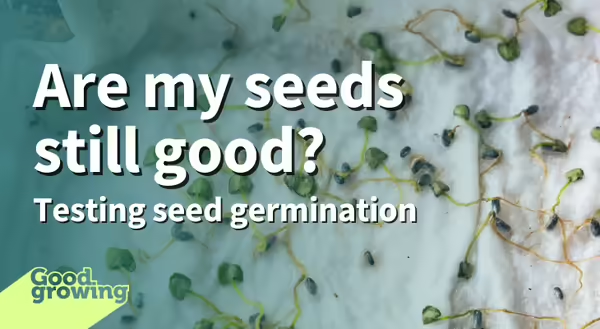
Have you ever found a packet of seeds lying around and wondered if you could grow them? Every year when I get ready to start seeds, I inevitably find a half-full packet or a packet I forgot to plant altogether. Unfortunately, as seeds get older, their germination rate decreases. Fortunately, there is an easy way to test your seeds to see if planting them will be worthwhile.
How long do seeds last?
Many seeds are capable of lasting for several years if stored properly.
- 4 to 5 Years: basil, broccoli, cabbage, cauliflower, cosmos, cucumber, eggplant, lettuce, nasturtium, oregano, pumpkin, radish, snapdragon, squash, sunflower, tomato, watermelon, and zinnia
- 3 years: bean, carrot, celosia, daisy, peas, poppy, okra, and pepper
- 1 to 2 Years: aster, coneflower, fennel, sage, onion, pansy parsnip, and sweet corn.
Checking seed germination
Download the PDF
Testing seed germination is relatively simple and only requires a paper towel, a sealable plastic bag or container, water, a permanent marker, and the seed you want to test.
- Moisten the paper towel and lay it flat
- Place 10 (can be more) seeds on the paper towel and fold the towel over the seeds.
- Place the paper towel in the plastic bag or container and seal it. This will help keep the paper towel from drying out. Label the container with the plant name and the date planted.
- Place the bag in a warm area, like on top of a refrigerator (just don't forget about it). Warmer temperatures (around 70°F) will help speed up the germination process.
- Every few days, check the seeds to see if they have germinated. Seed packets will often list how many days it will take for seeds to germinate. You can also use this information to help you determine when to start checking seeds. Many seeds will germinate within 7 to 10 days.
Once seeds have germinated, you can determine your percent germination; most people do ten seeds to make this calculation easy. If all of your seeds germinate, you can plant normally. If 70% to 90% of the seeds germinate, you can still use the seed, but you may want to sow a little heavier than normal. If fewer than 50% to 60% germinate, it is probably best to buy new seeds.
While most vegetables don’t require stratification, some flowers do. Plants like milkweed, purple coneflower, and black-eyed Susan require cold, moist stratification. If you have instances where you get no germination, make sure the plants you are testing don’t need some sort of stratification.
Properly storing seeds
If you have leftover seeds or are planning on saving seeds for next year, make sure you store them properly, so they remain viable as long as possible. Seeds should be kept cool and dry location, ideally below 45°F. Placing seeds in a sealed jar or bag in a refrigerator is a good option.
As a general rule of thumb, the sum of the temperature (°F) and percent relative humidity (RH) should be less than 100. So, storing seeds at 60°F at 30% RH would be good conditions. While storing seeds at 50°F and 60% RH would lead to reduced seed longevity.
Good Growing Tip of the Week: Seed germination and viability are often used interchangeably, but they mean different things. Germination is the ability of a seed to sprout. Viability is the seed’s ability to produce a vigorous seedling. Viability often declines before germination, so it’s possible for old seeds to germinate but produce weak seedlings.
Signup for our emails! Want to get notified when new Good Growing posts are available? SIGN ME UP
MEET THE AUTHOR
Ken Johnson is a Horticulture Educator with University of Illinois Extension, serving Calhoun, Cass, Greene, Morgan, and Scott counties since 2013. Ken provides horticulture programming with an emphasis on fruit and vegetable production, pest management, and beneficial insects. Through his programming, he aims to increase backyard food production and foster a greater appreciation of insects.
